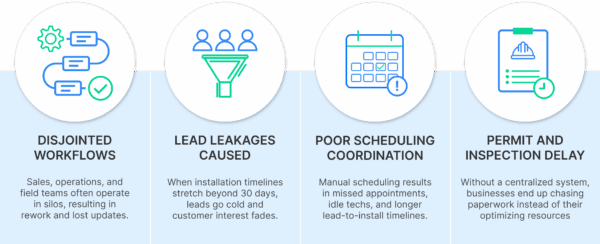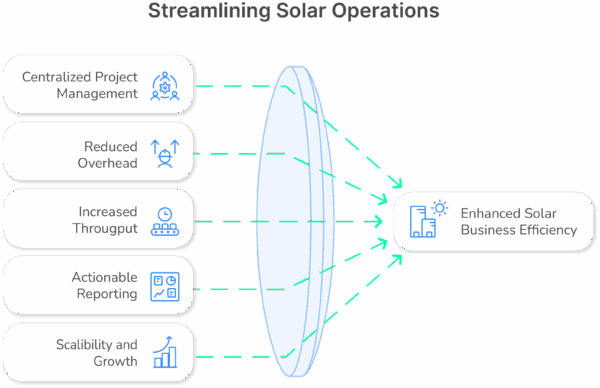
In the solar industry, scaling profitably is harder than selling. And that’s where most solar businesses run into a wall.
Customer acquisition remains one of the most expensive and operationally demanding aspects of running a solar company. According to recent data, soft costs, which include customer acquisition, permitting, inspection, and labor, now make up to 65% of the total cost of a residential solar PV system in the U.S. This isn’t just a small, isolated cost listed in your budget. It’s much bigger and affects the entire profitability of your business.
Worse, these costs are growing out of proportion to hardware savings. Panels have become cheaper. Installations have become faster. But manual paperwork, miscommunication, and pre-installation timelines are still dragging margins down.
So, how do you reduce soft costs without cutting corners?
The simple solution is to operationalize. Field Service Management software offers a direct path to lower customer acquisition costs (CAC) by reducing inefficiencies that are often invisible until they scale out of control.
In this blog, we’ll explore how solar businesses can use FSM software to cut costs, speed up installs, and improve the experience for both customers and teams, without sacrificing growth.
What Are Solar Customer Acquisition Costs?
Customer acquisition cost (CAC) refers to the total amount a solar company spends to gain a new customer. These costs aren’t just your ad spend or lead gen budget. In solar, CAC stretches across departments (sales, operations, logistics, and field teams) because of how many moving parts it takes to convert a lead into an install.
The breakdown includes:
- Initial lead generation and outreach
- Site assessments and consultations
- Permit paperwork, utility approvals, and interconnection
- Installation labor and admin
- Multiple follow-ups and schedule coordination
- Delays caused by misaligned teams or outdated systems
Every touchpoint that requires a phone call, a site visit, or a manual hand-off adds cost. And often, that cost is hidden in labor hours, lost leads, or rework.
Now consider that U.S. solar companies face higher soft costs than most developed markets. A Massachusetts Institute of Technology study found that soft costs in Germany are roughly 50% lower than in the U.S., largely due to more streamlined processes.
Solar soft costs aren’t fixed. They fluctuate based on how organized or disorganized your operations are.
That’s why top organizations treat operational efficiency as a scalable asset. Reducing soft costs by even 10–15% can massively impact project-level profitability and allow solar businesses to compete on price without slashing margins.
Challenges Solar Companies Face in Controlling CAC
Let’s not sugarcoat it. Solar startups and growing installers face real bottlenecks that inflate CAC:
Disjointed workflows:
Sales, operations, and field teams often operate in silos, resulting in rework and lost updates.
Lead leakage due to long sales cycles:
When installation timelines stretch beyond 30 days, leads go cold and customer interest fades.
Poor scheduling coordination:
Manual scheduling results in missed appointments, idle techs, and longer lead-to-install timelines.
Permit and inspection delays:
Without a centralized system to track progress, businesses end up chasing paperwork instead of optimizing resources.
All these invisible bottlenecks lead to a missed opportunity to bring down one of the most controllable costs in the business.

How Field Service Software Helps Lower CAC
Solar Field Service Management software directly addresses the roadblocks that drive up acquisition costs through operational clarity.
Here’s how:
Automated Scheduling and Dispatch
Field service software dynamically assigns jobs based on tech availability, skill, and proximity. This means no more back-and-forth calls or overlapping appointments. Such efficiency alone can shave days off your installation timeline.
Real-Time Customer Communication
Solar business software keeps customers in the loop without relying on manual follow-ups. You can send your customers an automatic appointment confirmation, an ETA update, or a completed installation summary. That means fewer drop-offs and higher close rates.
Live Team Visibility
With an FSM software, you know where your technicians are, what they’re doing, and how jobs are progressing in real time. This visibility helps you reallocate resources instantly when a job is delayed or an emergency reschedule is needed.
Smooth Permit Tracking
An integrated dashboard lets you track the status of every permit and inspection across jobs. This way, you don’t lose track of what’s been submitted.
Faster Closeouts and Documentation
Photos, checklists, signatures, and notes are captured on-site and synced instantly to the office. This accelerates the billing cycle and ensures clean handoffs between departments.

Together, these features significantly reduce the friction between lead and install and ultimately lower CAC by improving execution.
Benefits of Solar Business Management Software
FSM software streamlines tasks and reshapes how your entire business functions.
Centralized Project Management
From first contact to system activation, every stakeholder sees the same project status. No lost files, no crossed wires, no duplication.
Reduced Overhead
Field service software cuts down on manual tasks like invoice prep, timesheet entry, and appointment confirmations. This saves hours of admin work each week.
Increased Throughput
Faster installs mean more projects completed each month without needing to scale headcount. That directly improves CAC-to-revenue ratios.
Actionable Reporting
Track key KPIs like install time, technician productivity, and repeat visits. Spot bottlenecks before they become costs.
Scalability
FSM software grows with your business. Whether you’re managing 10 jobs a week or 1,000, the processes remain consistent and trackable.

And with industry data showing that installation costs decreased by 8% in 2023, those who optimize now are well-positioned to lead the next pricing wave.
Conclusion:
The U.S. added 8.6 GW of new solar module manufacturing capacity in Q1 2025. This makes it one of the largest expansions in solar manufacturing history. As supply increases and hardware prices continue to stabilize, the real margin gains will come from how efficiently you manage projects, not how cheaply you source panels.
Field Service Management software gives solar businesses the operational edge they need to stay profitable, scalable, and customer-friendly. By investing in smarter workflows, solar businesses lower customer acquisition costs, deliver faster installations, and unlock more capacity, without burning more resources.
In a nutshell, lowering CAC is an operational challenge, and FSM software is the solution built for it.
